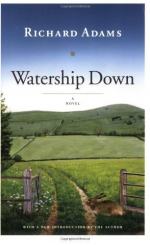|
This section contains 835 words (approx. 3 pages at 300 words per page) |

|
Watership Down Vs. the Wonderful Wizard of Oz
Summary: Both Richard Adams' Watership Down and L. Frank Baum's The Wonderful Wizard of Oz are filled with religious symbolism and allegory. This essay provides examples of such symbolism and offers an explanation of the message intended by both authors, which is centered on prophetic implication and religious associations.
The Wizard of Oz and Watership Down are both saturated with religious symbolism. Richard Adams and L. Frank Baum both take contemporary society's notion of allegorical relativity and transform it into episodic depictions via methodical personification. In Adams case, he uses rabbits. On the other hand, with the exception of Dorothy, Baum uses a Tin Man, a Scarecrow, a Lion, and a cast of other non-human creatures to create a world that is govern by laws and standards similar to those that we as humans govern ourselves by. Both stories are comparatively similar in thematic structure, however, major distinctions are mainly found in characterization. Nevertheless, each character plays a vital role in the message that both authors successfully convey which is centered on prophetic implication and religious associations.
In the beginning of Watership Down, when Fiver perceives impending danger of their warren, he activates a crusade. He attempts...
|
This section contains 835 words (approx. 3 pages at 300 words per page) |

|


